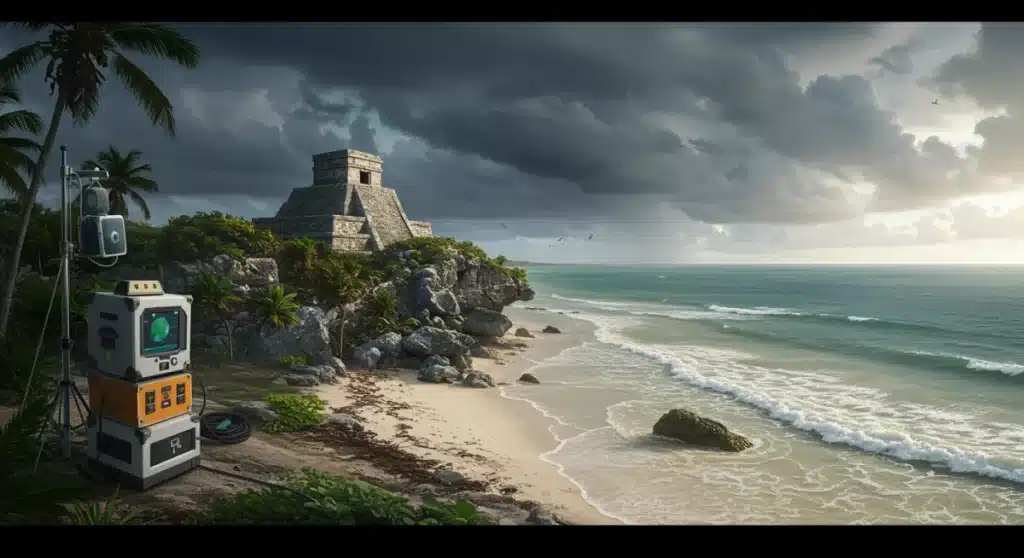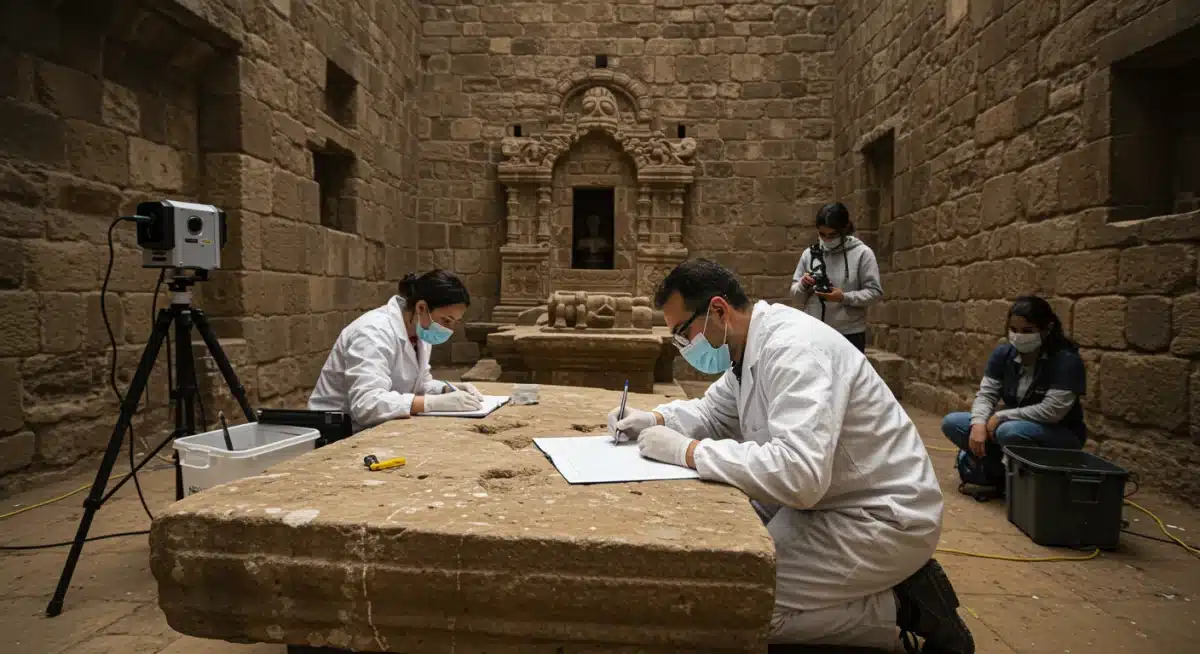Practical Solutions for Preserving New World Historical Sites

Practical Solutions for Preserving New World Historical Sites in the Face of Climate Change demands immediate, innovative strategies combining scientific advancements, community engagement, and robust policy frameworks to protect invaluable cultural heritage.
The escalating threat of climate change poses an unprecedented danger to the world’s irreplaceable cultural heritage, particularly impacting the vulnerable historical sites across the New World. As sea levels rise, extreme weather events intensify, and environmental conditions destabilize, urgent and innovative Practical Solutions for Preserving New World Historical Sites in the Face of Climate Change are not just important, but critical for safeguarding these treasures for future generations.
Understanding the Climate Threat to Heritage
New World historical sites, ranging from ancient Indigenous settlements to colonial-era architecture, face a myriad of climate-induced challenges. These threats are not hypothetical; they are actively eroding, flooding, and degrading sites from the Caribbean to the Pacific Northwest. Understanding the specific mechanisms of these threats is the first step toward effective preservation.
Coastal sites, for instance, are particularly vulnerable to sea-level rise and increased storm surges. Inland sites contend with altered precipitation patterns, leading to either increased erosion from heavy rainfall or structural damage from prolonged droughts. The interconnectedness of these environmental shifts demands a holistic approach to conservation.
Rising Sea Levels and Coastal Erosion
Many significant New World archaeological and historical sites are located in coastal zones, making them highly susceptible to the impacts of rising sea levels. The continuous battering of waves, combined with increased storm intensity, accelerates erosion, directly threatening foundations and exposing buried artifacts.
- Direct Inundation: Permanent submersion of low-lying structures and landscapes.
- Increased Salinity: Saltwater intrusion damages sensitive materials like stone and mortar.
- Accelerated Erosion: Stronger waves and storm surges wear away coastlines, undermining sites.
- Groundwater Changes: Altered water tables can destabilize foundations and promote decay.
Adaptive Management and Site Monitoring
Effective preservation in the face of climate change requires a dynamic approach. Adaptive management involves continuously monitoring environmental conditions and site responses, then adjusting preservation strategies accordingly. This contrasts with traditional, static conservation plans, acknowledging that the climate crisis necessitates flexibility.
Recent developments highlight the deployment of advanced sensor technologies at vulnerable sites. These sensors collect real-time data on temperature, humidity, water levels, and structural integrity, providing invaluable insights for proactive intervention. This data-driven approach allows conservationists to identify emerging threats and implement targeted solutions before irreversible damage occurs.
Technological Advancements in Monitoring
The integration of cutting-edge technology is revolutionizing how we monitor and protect historical sites. Drones, satellite imagery, and ground-penetrating radar offer non-invasive ways to survey large areas and detect subtle changes that might otherwise go unnoticed.
- Remote Sensing: Satellite and drone imagery track landscape changes, vegetation growth, and erosion patterns over time.
- Environmental Sensors: Real-time data on microclimates, moisture content, and structural movement within historical structures.
- 3D Scanning and Digital Archiving: Creates precise digital models of sites, serving as invaluable records and aiding in virtual reconstruction or planning physical interventions.
Community Engagement and Indigenous Knowledge
Preservation efforts are significantly strengthened when local communities and Indigenous populations are actively involved. These groups often possess invaluable traditional knowledge about their ancestral lands and historical sites, offering unique perspectives on environmental changes and sustainable land management practices. Their involvement ensures that conservation strategies are culturally sensitive and locally appropriate.
In many regions, Indigenous communities have been stewards of these lands for millennia, developing adaptive strategies to environmental shifts long before modern climate science. Integrating this traditional ecological knowledge with contemporary scientific approaches can lead to more resilient and effective preservation outcomes. Empowering local communities also fosters a sense of ownership and responsibility, vital for long-term sustainability.
Collaborative Conservation Initiatives
Successful projects often emerge from strong partnerships between heritage organizations, government agencies, local communities, and Indigenous groups. These collaborations facilitate resource sharing, knowledge exchange, and the development of comprehensive preservation plans.
For example, in parts of the Caribbean, local fishing communities are working with archaeologists to monitor submerged sites, providing critical observations on changes in coastal ecosystems and seabed conditions. This hands-on engagement builds capacity within the community and ensures that preservation efforts are sustained over time.
Innovative Engineering and Nature-Based Solutions
Physical interventions at historical sites must be carefully considered to avoid further damage or altering the site’s authenticity. However, in many cases, engineering solutions are necessary to protect structures from immediate climate threats. Increasingly, there’s a shift towards nature-based solutions, which leverage natural processes to provide protection while also enhancing ecological value.
These solutions include restoring coastal wetlands, planting mangroves, and developing living shorelines. These natural buffers can absorb wave energy, reduce erosion, and adapt to changing conditions more effectively than rigid, man-made structures. For inland sites, innovative water management systems, such as improved drainage and rainwater harvesting, are crucial.
Soft Engineering vs. Hard Engineering

While traditional hard engineering solutions like sea walls and breakwaters offer immediate protection, they can sometimes lead to unintended consequences, such as increased erosion elsewhere or ecological disruption. Soft engineering, or nature-based solutions, offers a more sustainable and environmentally friendly alternative.
- Living Shorelines: Using natural materials like oyster reefs, salt marshes, and native vegetation to stabilize shorelines and reduce erosion.
- Mangrove Restoration: Planting mangroves provides natural coastal protection, supports biodiversity, and sequesters carbon.
- Erosion Control with Vegetation: Strategic planting of native species to stabilize slopes and prevent soil loss at inland sites.
- Managed Retreat: A last-resort strategy involving the planned relocation of non-critical elements or entire sites away from immediate threats.
Policy Frameworks and Funding Mechanisms
Effective preservation requires robust policy frameworks at local, national, and international levels. These policies should integrate climate change considerations into heritage protection legislation, ensuring that climate resilience is a core component of conservation planning. Furthermore, securing adequate funding is paramount for implementing large-scale and long-term preservation projects.
Governments, international organizations, and private foundations must allocate resources specifically for climate adaptation and mitigation efforts at historical sites. This includes funding for research, technological deployment, capacity building for local communities, and the physical implementation of protective measures. Without sustained financial support, even the most innovative solutions will remain unimplemented.
International Cooperation and National Legislation
The global nature of climate change necessitates international cooperation to share best practices, pool resources, and address cross-border threats. National legislation plays a critical role in providing the legal framework for protecting heritage and integrating climate considerations into development planning.
For instance, some nations are beginning to amend their heritage laws to explicitly address climate change impacts, mandating climate vulnerability assessments for all listed historical sites. International bodies like UNESCO are also facilitating dialogues and initiatives to support member states in their efforts to protect World Heritage sites from climate threats.
Education, Awareness, and Future Planning
Raising public awareness about the climate threats to historical sites is crucial for garnering support for preservation efforts. Educational programs can inform citizens about the value of their cultural heritage and the urgency of climate action. Engaging the public, from schoolchildren to policymakers, fosters a collective responsibility for safeguarding these irreplaceable resources.
Future planning involves not only reacting to current threats but also anticipating future climate scenarios. This includes developing long-term strategies that incorporate climate projections, ensuring that today’s preservation efforts remain relevant and effective decades from now. It’s about building resilience and adaptability into the very fabric of heritage management.
By investing in education, fostering public engagement, and committing to forward-thinking strategies, we can create a more informed and proactive society capable of protecting its shared past against the challenges of a changing climate. This collective effort is essential for ensuring that the stories embedded in New World historical sites continue to inspire and educate future generations.
| Key Solution | Brief Description |
|---|---|
| Adaptive Management | Continuous monitoring and adjustment of preservation strategies based on real-time climate data. |
| Community Engagement | Involving local and Indigenous communities to integrate traditional knowledge and foster local ownership. |
| Nature-Based Solutions | Utilizing ecological processes like mangroves or wetlands for protection against climate impacts. |
| Policy & Funding | Establishing robust legal frameworks and securing financial resources for long-term preservation efforts. |
Frequently Asked Questions About Heritage Preservation
Primary threats include sea-level rise, increased coastal erosion, intensified extreme weather events like hurricanes and droughts, and altered precipitation patterns, which collectively destabilize structures and accelerate decay.
Technology assists through real-time environmental sensors, drone and satellite monitoring for landscape changes, and 3D scanning for digital archiving and precise intervention planning, enabling proactive conservation.
Community involvement, especially from Indigenous populations, is vital as they offer traditional knowledge, local insights, and a sense of ownership, ensuring culturally sensitive and sustainable long-term preservation strategies.
Nature-based solutions leverage natural processes, such as restoring mangroves, creating living shorelines, and using vegetation for erosion control, providing ecological benefits while protecting sites from climate impacts.
Robust policies integrate climate change into heritage legislation, while dedicated funding from governments and international bodies ensures resources for research, technology, community capacity building, and implementing protective measures.
What Happens Next
As climate change impacts continue to accelerate, the focus on Practical Solutions for Preserving New World Historical Sites in the Face of Climate Change will intensify. Expect to see increased international collaboration on shared heritage threats and the development of more sophisticated predictive models to anticipate future risks. The coming years will likely feature a greater emphasis on integrating climate resilience into all aspects of urban planning and cultural resource management. Watch for new funding initiatives and policy shifts aimed at safeguarding these invaluable sites, underscoring a growing global commitment to heritage protection amidst environmental upheaval.